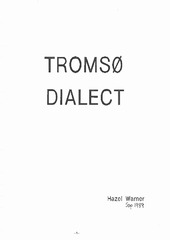| dc.description.abstract | The Tromsø dialect situation today is probably typical of many Northern Norwegian town dialects. It has developed from an old local non-standard speech variety which was very similar to the present local rural dialects. What clearly distinguishes the modern town version, as spoken by young people today, from the old one, however, is the inclusion of a significant number of bokmål features. This study investigates which particular bokmål features have been adopted and which dialect features dropped. Variables within the group of teenage informants were sex, social status of the parents and place of origin of the parents. These variables were each investigated separately to see if there was any relationship between them and the percentage of bokmål forms used. <p>
<p>Clear evidence of a Thelander Regional Standard was found. <p>
<p>An apparent absence of style-shifting was also noted. | en_US |


 English
English norsk
norsk
